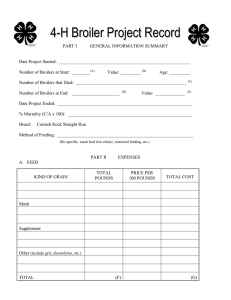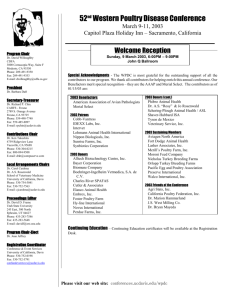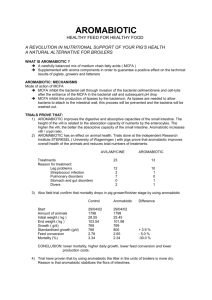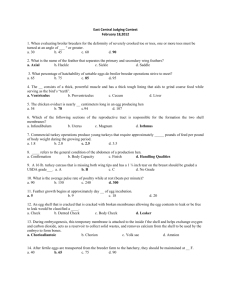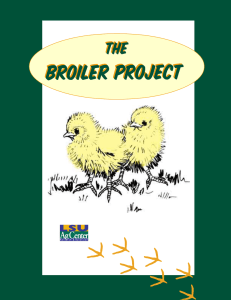Mome Unit Poultry Project Zke DATE.
advertisement
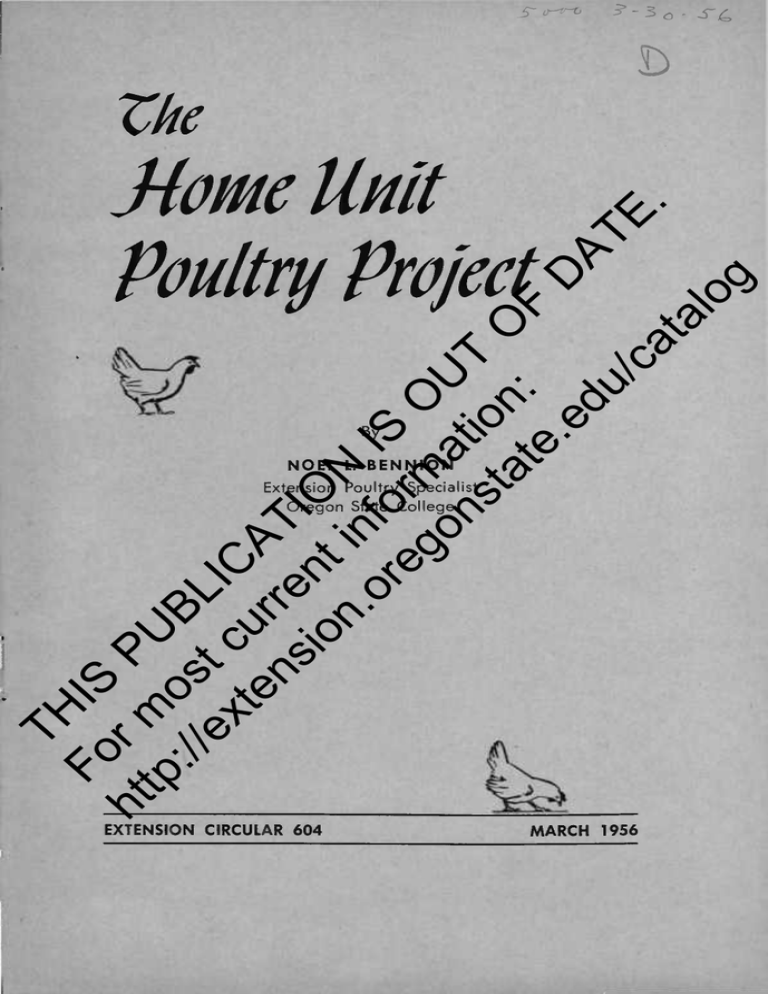
Zke TH Fo IS ht r m P U tp o :// s BL ex t c IC te ur A ns re TI io nt ON n. in or fo IS eg rm O on at U st ion T O at : F e. D ed AT u/ E. ca ta lo g Mome Unit Poultry Project By NOEL L. BENNION Extension Poultry Specialist Oregon State College EXTENSION CIRCULAR 604 MARCH 1956 Wkat it Costs to Kaise payers and %roilers TH Fo IS ht r m P U tp o :// s BL ex t c IC te ur A ns re TI io nt ON n. in or fo IS eg rm O on at U st ion T O at : F e. D ed AT u/ E. ca ta lo g I HE HOME UNIT POULTRY PROJECT may consist of layers or broilers or a combination of both. Some suburban dwellers with a little acreage may be interested in raising enough broilers or keeping enough layers, or both, to provide the family with what eggs and poultry meat it will consume. Others may want to develop a sideline unit large enough to supplement the family income. This will be especially true if we should have a depression or period of unemployment. ITEMS TO CONSIDER FOR LAYERS SIZE OF FLOCK: 1 2 to 25 layers or more. Some people may want to carry as many as 500 layers or more to supplement the family income. INVESTMENT: $1 to $3 per bird for housing and equipment. LABOR INCOME: About $2 per bird. PRODUCTION: About 225 eggs or more per hen per year. FEED: Feed consitutes about 65% of the cost of producing market eggs. Consumption will range from 80 to 100 pounds per bird depending on breed and production. Layers will consume from 25 to 30 pounds of total feed per day per 100 birds. Feed costs can be reduced by the use of table scraps and garbage with small units. MORTALITY AND CULLING: About 2% a month. LABOR: From 1 to 3 hours per bird per year depending on size of unit and efficiency. 2 EXTENSION CIRCULAR 604 BREEDS: The most -common breeds in Oregon are White Leghorns, New Hampshires, Rhode Island Reds, White Rocks, and some crossbreds. TH Fo IS ht r m P U tp o :// s BL ex t c IC te ur A ns re TI io nt ON n. in or fo IS eg rm O on at U st ion T O at : F e. D ed AT u/ E. ca ta lo g HOUSING: Housing can be on litter in a conventional house, in open air houses with wire floors, in community cages with 15 birds to a group, or in individual cages. These systems all will work reasonably well in Western Oregon with proper management. Birds are more susceptible to high and low temperatures on wire in open air houses. This means more variation in production. Droppings from birds on wire in open air houses or shelters present a fly problem that is not easy to handle. ITEMS TO CONSIDER IN RAISING BROILERS SIZE OF FLOCK: 25 to 100 or more. Some people may want to raise 100 or more per week as a continuous operation or 500 or more under the "all in—all out system," as a sideline to supplement the family income. INVESTMENT: Investment will range from $1 to $2 per broiler for equipment depending on system used. PRODUCTION COSTS OF 3-POUND BROILER: Cost per bird raised Feed (9 pounds @ 5?;) Chicks Brooder fuel Miscellaneous (litter, vaccine, taxes) Depreciation Interest $ .45 17 03 03 04 02 Total $ .74 FEED: Feed constitutes about 2/3 of the cost of raising broilers. It requires about 9 pounds of feed to produce a 3pound broiler in about 10 weeks. Good operators will do better than this. HOME UNIT POULTRY PROJECT 3 TH Fo IS ht r m P U tp o :// s BL ex t c IC te ur A ns re TI io nt ON n. in or fo IS eg rm O on at U st ion T O at : F e. D ed AT u/ E. ca ta lo g TYPE OF OPERATION: Broilers can be raised on the floor in a similar manner as replacement chicks or in wire batteries. The results will be similar. The "all in-all out" operation means you raise and sell a batch of chicks and clean out the house before starting a new group. In a continuous operation you start chicks at regular intervals, such as a new group every 1 or 2 weeks. The system used depends on your marketing program. Disease hazards are greater under the continuous program. MARKETING: If you are raising broilers to sell, do not start chicks unless you have a buyer who will take them when they are ready for market. MORTALITY: Mortality should not be over 5% up to 10 weeks of age. BREEDS: The most common breeds for broiler production are New Hampshires, White Plymouth Rocks, and crossbreds. LABOR INCOME: Labor income will range from nothing up to 25$ per bird depending on market prices and whether you do your own processing and sell direct to consumers. This income may be higher when the market is good if a producer processes and sells direct. 4 EXTENSION CIRCULAR 604 TH Fo IS ht r m P U tp o :// s BL ex t c IC te ur A ns re TI io nt ON n. in or fo IS eg rm O on at U st ion T O at : F e. D ed AT u/ E. ca ta lo g Housing and Squipmentfor Cayers and Mr oilers MANY POULTRYMEN use a radiant-ray infrared brooder. It can be obtained in different sizes. UNDERSIDE of homemade 50-chick capacity brooder. HOME UNIT POULTRY PROJECT 5 TH Fo IS ht r m P U tp o :// s BL ex t c IC te ur A ns re TI io nt ON n. in or fo IS eg rm O on at U st ion T O at : F e. D ed AT u/ E. ca ta lo g CHICK BROODING EQUIPMENT INTERIOR OF AN 8x12 foot laying house equipped with nests on wall opposite the door. Right, dropping pit roosts. Left, feed hopper. 6 EXTENSION CIRCULAR 604 TH Fo IS ht r m P U tp o :// s BL ex t c IC te ur A ns re TI io nt ON n. in or fo IS eg rm O on at U st ion T O at : F e. D ed A u/ TE ca . ta lo g m£ AN 8x12 FOOT home unit poultry house used for growing pullets. OUTDOOR or "sunshine" brooder is useful in brooding chicks for replacement in cage operations. Infrared bulbs are used in brooder for heat. This can be used for layers also. HOME UNIT POULTRY PROJECT 7 TH Fo IS ht r m P U tp o :// s BL ex t c IC te ur A ns re TI io nt ON n. in or fo IS eg rm O on at U st ion T O at : F e. D ed AT u/ E. ca ta lo g AN 8 x 12 FOOT HOUSE equipped with a wire porch. It will handle 25 layers or 100 broilers. A LAYING HOUSE designed to handle 1,000 layers or 3,000 broilers. TWO-STORY LAYING HOUSE that can also be used for raising broilers. It will accommodate 2,000 layers or 6,000 broilers. TH Fo IS ht r m P U tp o :// s BL ex t c IC te ur A ns re TI io nt ON n. in or fo IS eg rm O on at U st ion T O at : F e. D ed AT u/ E. ca ta lo g BATTERY used for starting broilers for first 3 weeks. AN INTERMEDIATE BATTERY used for broilers from 3 to 6 weeks of age. A FINISHING BATTERY used for broilers from 6 weeks until marketed. TH Fo IS ht r m P U tp o :// s BL ex t c IC te ur A ns re TI io nt ON n. in or fo IS eg rm O on at U st ion T O at : F e. D ed AT u/ E. ca ta lo g THESE COMMUNITY CAGES are the back-to-back type with 3x5 foot units. They will hold 15 layers per unit. Sloping floors permit eggs to roll out into egg troughs or baskets. Community cages may also be used for rearing pullets, as shown here. A LATH-TYPE COMMUNITY CAGE house built with a single row of units on each side of a central alleyway. 10 EXTENSION CIRCULAR 604 TH Fo IS ht r m P U tp o :// s BL ex t c IC te ur A ns re TI io nt ON n. in or fo IS eg rm O on at U st ion T O at : F e. D ed AT u/ E. ca ta lo g OUTDOOR-TYPE INDIVIDUAL CAGE HOUSE with one row of cages on each side of the aisle. Cages range from 9 to 12 inches wide and are 16 to 18 inches deep. Baffle boards along sides protect layers from afternoon sun and from heavy rains. Allowing droppings to form cones encourages drying and discourages fly breeding. THIS 20 x 20 foot colony-type "open-air" laying house was constructed at OSC in 1947. Note the community nests in front and the spaced lath wind-break in back. HOME UNIT POULTRY PROJECT 11 TH Fo IS ht r m P U tp o :// s BL ex t c IC te ur A ns re TI io nt ON n. in or fo IS eg rm O on at U st ion T O at : F e. D ed A u/ TE ca . ta lo g o D O Q. O $ E o iij > U Q£ h- III o FEDERAL COOPERATIVE EXTENSION SERVICE OREGON STATE COLLEGE CORVALLIS Cooperative Extension work in Agriculture and Home Economics, F. E. Price, director. Oregon State College and the United States Department of Agriculture cooperating. Printed and distributed in furtherance of the Acts of Congress of May 8 and June 30, 1914.
